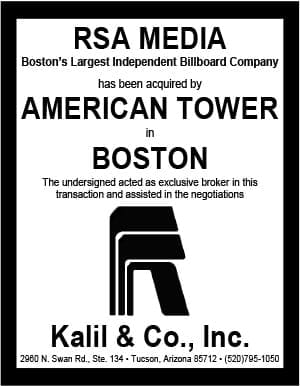 Jesse London has 25 years experience in media sales including 20 years experience selling out of home. Last week he talked about selling out of home versus TV. Today he talks about 7 ways out of home complements online and mobile ads.
Jesse London has 25 years experience in media sales including 20 years experience selling out of home. Last week he talked about selling out of home versus TV. Today he talks about 7 ways out of home complements online and mobile ads.
How do you see out of home working with digital tech?
(1) Out of home has a wide audience and is a critical touchpoint in an advertisers’ marketing mix. The digital experience is one to one, whereas out of home is one to many; the broad reach of outdoor drives initial brand awareness and nudges consumers into the buying funnel where digital plays a critical role. A 2017 Nielsen study showed that out of home delivers more search activity per ad dollar spent, then radio, TV or print. That is why the top four commercial sites on the web (YouTube, Facebook, Twitter, and Amazon) all spent significantly in out of home last year.
(2) Roughly 70% of US digital impressions are mobile. Mobile and out of home work reach a digitally savvy active consumers on a path to purchase. By combining out of home and mobile media, we can drive relevancy, create reinforcement, extend reach, and provide targeted frequency. Research supports the synergy between the two mediums: MRI/Simmons reports that an out of home audience is more likely to be engaged with their mobile phone than the audience of any other medium, a 2019 Nielsen study revealed that two thirds of smartphone users took some sort of action online after seeing an OOH ad, and Ocean Neuro Insights reports that pairing OOH with mobile can increase ad engagement rates by nearly 50%.
(3) Mobile data provides operators insights into individual billboards. The new Geopath location measurement tools provide demographics, traffic counts (pedestrian & motorist), the speed by which someone drives by (dwell), and trip information. Large operators or the advertisers can use third party data that can show more detailed audience segment profiles based on the behavior of the audience driving by – for example an audience profile might be “in the market for a car” (phone has been to several car showrooms recently) or “first time home buyer” (phone just started sleeping at a new location/made recent trips to furniture and home improvement stores). Advertisers can target a very specific, well-measured audience. Armed with this new data local sales teams are reporting that they have more confidence on sales calls.
(4). Marketers can retarget potential consumers driving by specific locations, and create geofences around individual billboards. This amplifies the initial billboard impression by providing a narrowly targeted second point of contact. Some billboard operators also sell a geofence alone in the event the advertiser needs a neighborhood not served with outdoor.
(5). The mobile experience offers robust performance metrics. Advertisers know when ads were served, on what sites, at what physical location and at what time. This promotes transparency and brand safety. Online retailers and foot traffic attribution companies are starting to provide ROI metrics that show that mobile drives purchase, and the same tech can show that the media mix works better when a billboard creates awareness at the top of the funnel.
(6). Advertisers are buying their digital media programmatically. Agencies are buying audiences via programmatic platforms using frictionless software instead of physical RFP’s. Now that out of home has rich data, companies are reporting increased programmatic revenue from companies like Adomni, Place Exchange, Blip, and Vistar. The partnership of Blip and Cedric Bernard to form Adkom is likely to create a new source of national programmatic dollars for independent operators. Agencies want to buy outdoor with better audience measurement, quicker transactions, less labor, and reduced errors. For these reasons the out of home programmatic spend will continue to grow.
(7). Mobile is a powerful tool, and it makes sense to embrace the platform. Many sales organizations are partnering with local mobile providers to prepackage a mobile + ooh offer. In 2018 ad spending in mobile was roughly $70 billion and climbing, while out of home spend was $8 billion. Mobile is generating nearly nine times the ad revenue. Out of home companies need to tap into that market.
[wpforms id=”9787″]
Paid Advertisement

















